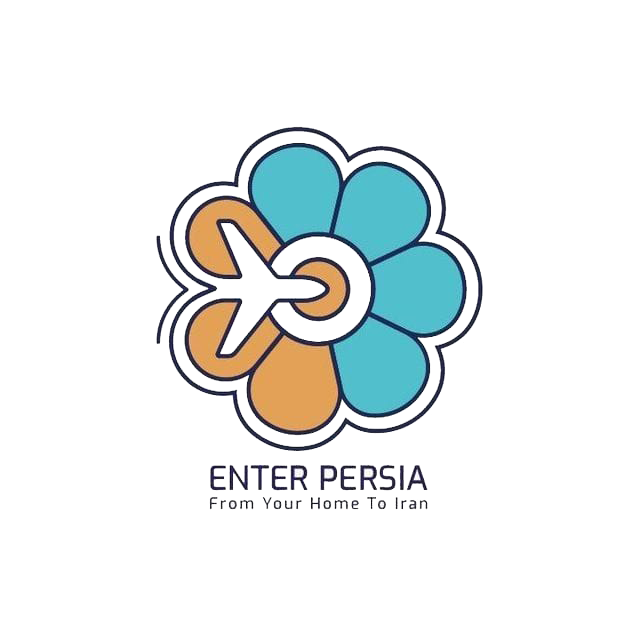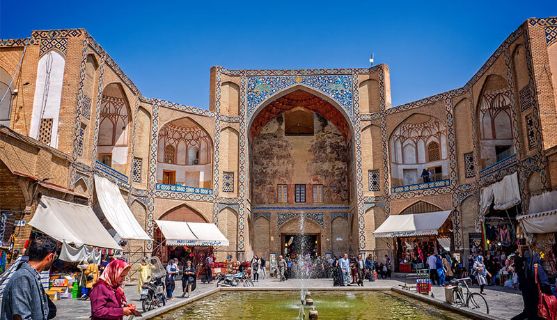The Qeysarie Gate in Isfahan is one of the most valuable relics of the Safavid period. This building is located in the north of Naqsh-e Jahan Square and front of Imam Mosque. Its construction was completed during the reign of Shah Abbas I (11 AH) and its architect was Master Ali Akbar Isfahani. This relic has been registered as one of the Iran National Heritage.
Qeysarie Gate includes four side doors, a main gate and a pond, which became a garden around the 1940s, but has now been restored.
The bell and the clock in the Portuguese castle on the island of Hormuz (about 80 cm in diameter) were brought to Isfahan after the conquest of that island and were installed on top of this gate, which unfortunately has no trace now.
The Qeysarie Gate was built on two high floors, the upper floor of which was dedicated to office and business, and the lower floors of various guild shops were located next to each other.
Paintings
The front wall (above the entrance) shows Shah Abbas’s war with the Uzbeks. The wall on the right shows Europeans dancing and singing; The wall on the left is also a hunting ground painting that depicts a theme from the past that shows separation from filth and attaining purity.
At the top of the gate, the constellation of Isfahan (Sagittarius) can be seen. In this tile work, the body of a young archer in Safavid clothes and with the trunk of a lion and the tail of a dragon can be seen shooting at one side. This image shows the scene of the fight, in which Arash the Archer is shot with the tail of a legendary animal. In ancient times, it was common among the civilized nations of the world to give a fortune to their famous cities, and after choosing Isfahan as their capital, they chose the Sagittarius for its fortune.
On both sides of the gate there are two large platforms covered with jade and sumac, and in those days goldsmiths and jewelers spread their baskets on them and offered a variety of ornaments and rare coins to buyers.
Architecture
The interior ceiling of the entrance is made of very beautiful brick red and Navy blue tiles with Islamic designs in the form of muqarnas. During the reign of the Qajar dynasty and the reign of Mass’oud Mirza Zell-e Soltan, the ruler of Isfahan, changes were made in the facade of the Qeysarie Gate and a tiled margin was added along the three sides of the gate.
Naming
Jean Chardin, who has lived in Isfahan for many years, described the Qeysarie Bazaar in detail and named it Qeysarie because the gate was built like one of the buildings of Caesarea in Asia Minor (Turkey).
Qeysarie bazaar
From the Qeysarie Gate, we enter the most luxurious and largest markets of Isfahan. This bazaar, which is also known as Qaisariyeh and Shahi Bazaar, was a center for selling precious fabrics in the Safavid era, and the representatives of foreign companies had rooms in them.
In the past, this bazaar was called Soltani Bazaar and during the Safavid period, it was one of the largest bazaars of its time. Qeysarie bazaar connected the old part of Isfahan called Kohneh Square or Isfahan of the Seljuk era to the new part of Isfahan in the Safavid period.
The bazaar was built on three floors, the second floor of which was for office and commercial affairs, and the lower floor for the shops of the various guilds. The third floor of the bazaar, which was destroyed today, used to be a “Naqqareh Khaneh”, where the sound of music was used to announce the time of day.
In fact, “Naghare Zani” (drumming) has been common in Iran for a long time, but not only for the announcement of sunrise and sunset, but also for military readiness, in various rituals and on different occasions, informing important news.



Very interesting points you have observed, thank you for putting up.Blog monry